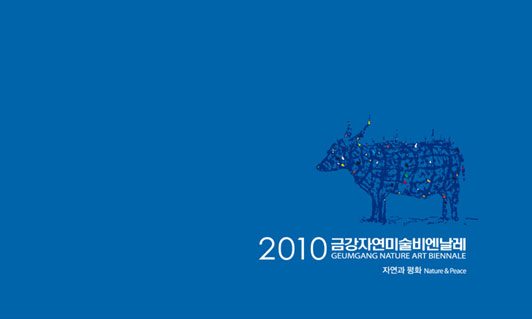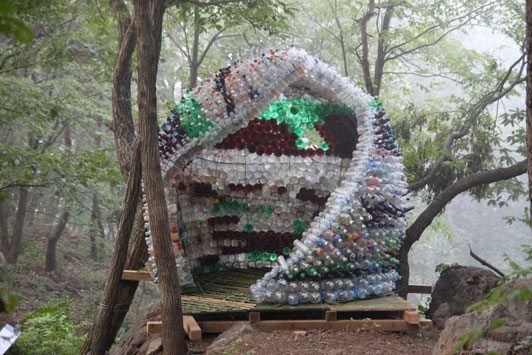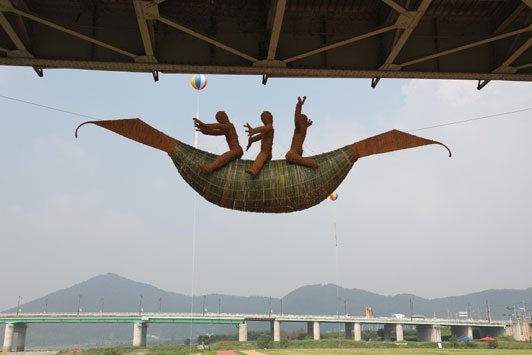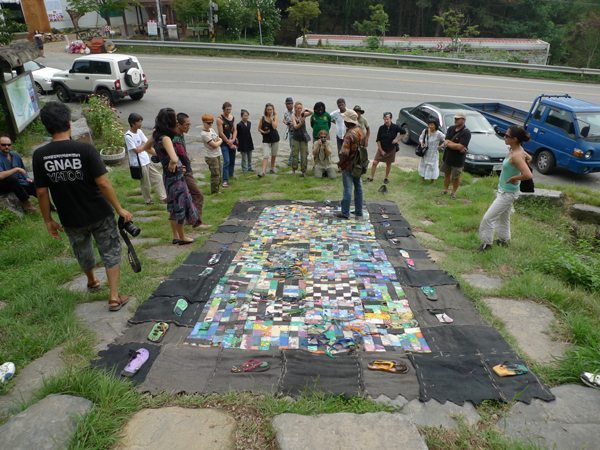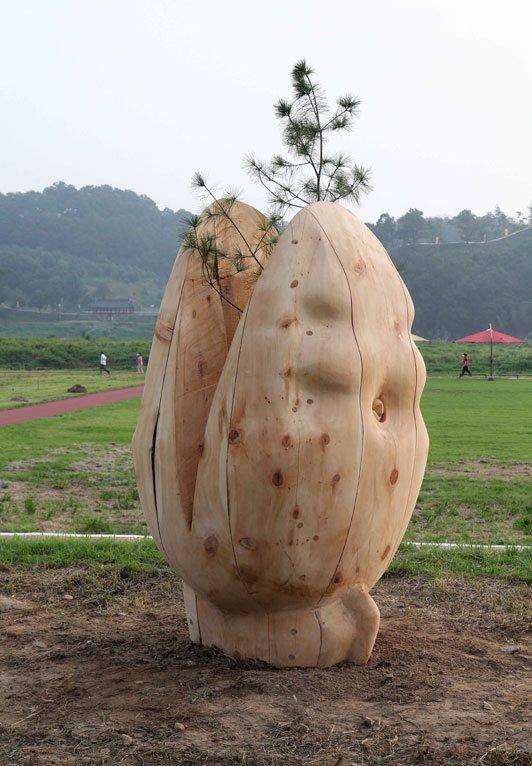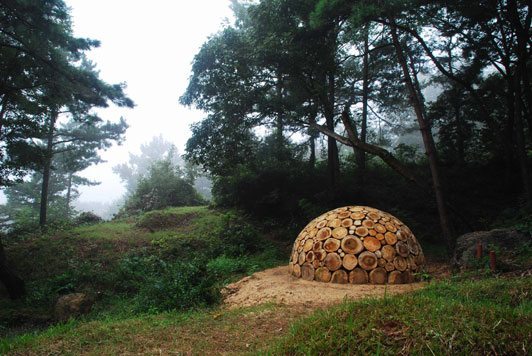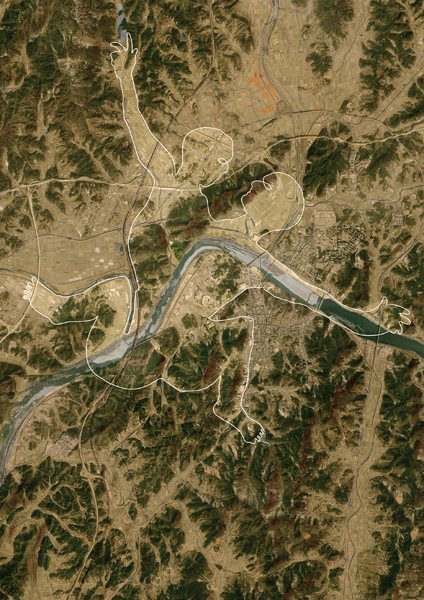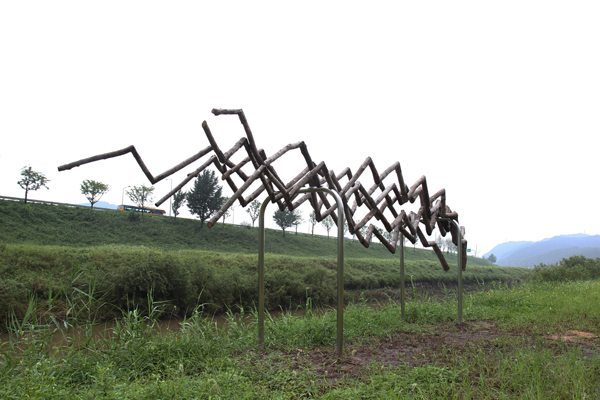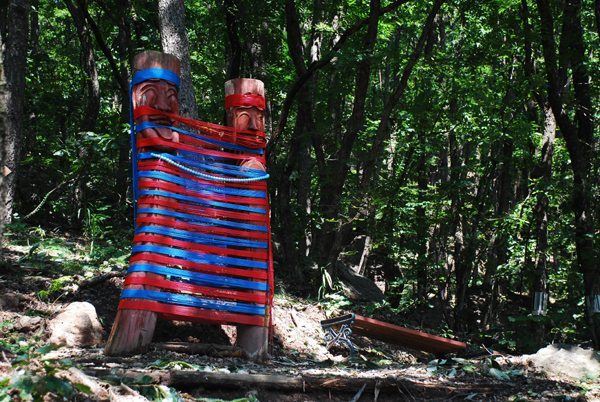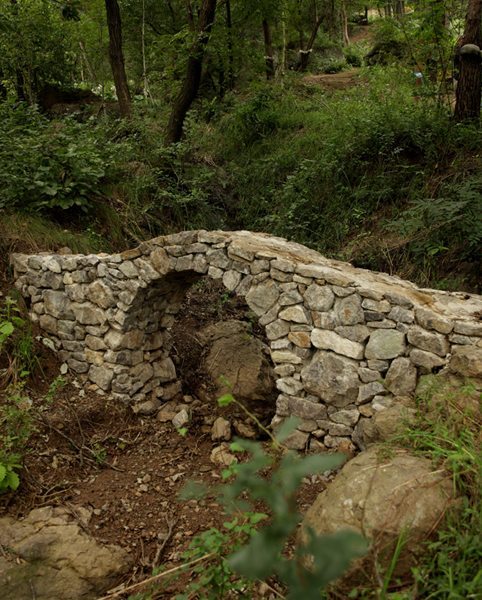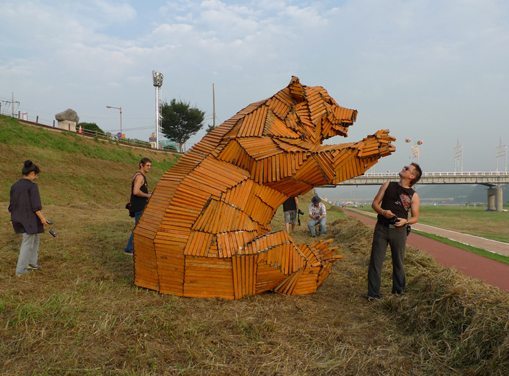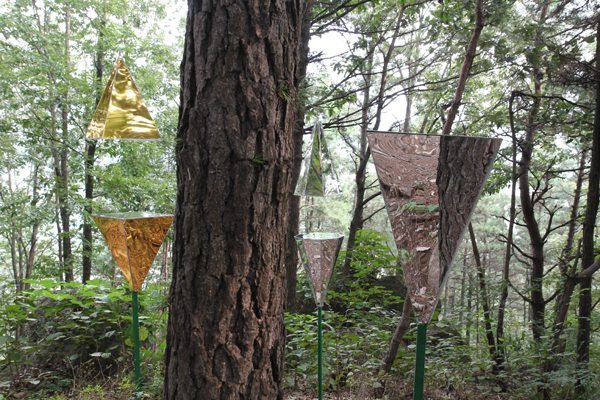Location: Gongju, South Korea
I. HISTORY
Geumgang Nature Art Biennale WAS FIRST HELD IN 2004 and again in 2006 and 2008. This year, 2010, it is titled Nature and Peace.
Yatoo was founded almost 30 years ago in Gongju, in the Chungnam Province, 150 km south-west of Seoul. Yatoo is the name of the Korean Nature Artists Association that organizes the Geumgang Nature Art Biennale and means “Thrown into the field”. The Korean artists use the term ‘thrown into field’, because as Koreans, they feel the responsibility for nature is theirs. Why? Korea is a unique country in many ways. A technically advanced society, it lives collectively in respect for ancient culture and nature. It requires individuals to responsibly share their experiences abroad, to learn from other cultures how to honor nature because many countries have this problem. This has resulted in Korea being one of the largest Nature Art centers in the world.
In Nature Art, nature plays the role of co-creator and instigator. This creates a number of consequences for the artists who want to create “in unison with nature”. They need to show humility and a deep understanding of the processes taking place around them in nature. Nature Art, being the art closest to our roots, educates and moralizes us, making us more reflective. This kind of art is usually outside roofed galleries enabling contemplation within the natural world. And so it happens in the case of Geumgang Nature Art Biennale. Installations are shown in the Ecological Park near Jeongancheon stream and the river bank of Geumgang, creating a joint exhibition entitled Where is the Swallow?. This title refers, first to the name of the mountain, Yeonmi, or Swallow Tail, where the park is located. Secondly, these birds were once abundant and nesting close to people in the eaves of roofs. Now due to human activity swallows are very rare in South Korea.
Within the exhibition’s title and the rhetoric of the artworks is a reflection of how people could behave so as not to discourage or disrupt other species, as they have discouraged swallows. How can one live in harmony with the whole of nature? Art gives us advice in finding answers to this tricky question. Trees, water, light, sound and even wind become part of the artists’ installations. They will be standing on site for some time and the site will change its form and structure with help from nature itself. The whole process can be observed in the park and at the Geumgang riverbank throughout the year.
The combined rich and diverse histories of this year’s participants guarantee a high level of quality work. We have 15 artists from 13 different countries: Ghana, Cameroon, India, Poland, USA, Germany, Peru, Philippines, Netherlands, New Zealand, USA, Canada, Hungary, Bulgaria and Japan, and 12 artists from the host country, South Korea. The character of each creator’s piece is shaped by the unique culture, history and geography of his or her country of origin. Each piece is also marked by the artist’s specific relationship to nature. It is not surprising that the installations differ from each other to such an extent.
II. INTERNATIONAL EXHIBITING ARTISTS
KAREN MACHER NESTA, PERU, IS AN ARTIST who believes in specific interaction between Mother Earth and her inhabitants. In the ancient beliefs of her country, the land must be respected. Consequently people offer gifts to nature: fruit, animal blood, cocoa leaves etc, asking her to be more fertile and calm. Earthquakes are also in her nature, and if it comes to this kind of disaster, it means that she is angry.
The artist used rabbits as a symbol of fertility because of their fast-reproducing capability. The rabbit figures were made from clay, and were designed to last for a short period of time only, in order to return to the earth where they came from (some cement has been added to extend this period). The act of making the rabbits was like a fertility ritual, asking the land to never stop providing for us; it is an offering to allow us live together in peace and harmony.
Over thirty larger-than-life rabbits are located around the main path in Ecological Park. The rabbits will eventually disappear and be absorbed into the forest floor.
DUTC ARTIST, KARIN CAN DER MOLEN´S SHELL object is part of a series of art works in nature in which she creates an entry to the natural world for people who grew up in an urban, technological society. The Ocean in a Shell is a metaphor for the vastness of the natural world that we are a part of. This shell is too big to hold to your ear. It explores the meaning of being as wide as the ocean itself.
NEREUS PATRICK CHEO, CAMEROON, WAS INSPIRED BY debris ejected onto the beach by the Atlantic ocean to create The Watch Tower Kiosk. He used found plastic water, beer and soft-drink bottles to make an open structure which talks about a worldwide problem: a great majority of the world’s population consumes water and drinks from these bottles but at least half of these bottles have never been recycled.
His project entailed the construction of a Kiosk-like shape 5m high and 3m x 4m wide. The kiosk is a dome-shaped sculpture beautifully created from used bottles woven together with wire combined with bamboo, wood and nails. Utilizing the bottles as an artistic statement, he has given them new life.
The work offers an opportunity for attention, care and open vistas for reflection on how we interact with our environment.
FOR ROGER TIBON, PHILLIPPINES, THE WATCHWORDS “nature and peace” are metaphors for a journey uniquely associated with the boat. This is not surprising considering that the Philippines are comprised of more than seven thousand islands. Many Filipinos have never left this environment, and, within the islands, most people travel by boat.
The boats are more than just a way of movement and communication for them. Filipinos have extremely emotional attitude towards their boats. Boats take us from one destination to another; they can be a journey towards one’s aim or dream in life; they can be journey towards communicating and understanding one another in order to achieve peace; boats can be a spiritual journey. Life itself is a journey; we are all in the same boat navigating through this particular lifetime.
The river of existence is sometimes rough and sometimes pleasant. Individually and collectively, we have the responsibility to harmonize with one another and with nature to keep our balance. We have to understand the ways of nature, ourselves and other people. For, if we don’t, we can easily go astray and into troubled waters of conflict, argument, and confusion. The boat, with three figures on it, has been installed hanging under one of the cities’ bridges enabling many people to cross over this traveling symbol. Of course the real contemplation begins when we reach a beautiful riverbank and silently, listening to the sound of the water, we gaze at the sculpture from a distance.
Roger Tibon is internationally known as a visual and nature artist. At home he is also active as a poet and occasionally as a martial arts and visual arts teacher of younger artists concerned with nature and the Philippine culture.
PATTRICK TAGOE-TURKSON, KUMASI, GHANA. TO MAKE people think, Patrick created a holy carpet and performance titled ‘Holy Ground’. The work is made from found slippers (flipflops) debris and jute sacking. His work reflects on the continuous dilemma of people’s dealings with nature and how to reestablish people’s connection to nature. He hopes to capture the audience’s attention with beautiful colours, and to sustain their attention as they experience the whole work by walking on it and observing its detail. The work gives us much to reflect on: the lifespan of objects (and for that matter, our actions), our mass consumerism, what we accept as being valuable and what we reject as worthless.
The carpet has been installed in front of the main entrance to the Ecological Park, so everyone who wants to contemplate nature in a forest, or just get some exercise, can take off his or her shoes and… ‘think about thinking’. Thinking about our roots can be the beginning of an adventure with the park. Cleared by their initial intervention with the carpet, visitors become more sensitive to the soul-healing effects of nature.
THE WORK OF PAWEL CHLEBEK ODEBEK, POLAND, REFERS to central values such as family, love, and care. In The New Generation the artist points out the mystery of new life and implies its dependence on our care. Eventually the project will result in the interaction between the carved form and nature’s power (as the growing tree trunk expands). Time is co-creator of this piece.
The art-work is a pine sapling planted in soil between the two large opposing torsos, male and female. The torsos and the tree are both pine from different countries; Chile and Korea. We are similar people under different flags, our needs are alike, and we should all think about shaping a new and healthy world.
Visitors to the Geum Riverbank, will witness this co-creation for a long time to come. Whether the tree and sculpture survive or not is nature’s call. The tree may grow into the torsos and after a few years, tear them apart. The uncertainty of the outcome makes this piece even more interesting.
THE TWO WILLOW WATER BUFFALO BY JAPANESE ARTIST EIZO SAKATA are works ‘in situ‘, inspired by the place, with willow from nearby. One Water Buffalo stands in a water installation near the entrance of Yeonmisan Art Park. The other is set up in a portion of the Riverside-Park wetland near Yeonancheong. The willow will root and grow and the branches will return to their life. In fact, owing to a lot of rain during the exhibition period, buds appeared quite soon and green leaves are now growing. In time the buffalo will look like a green-leaved animal. Eizo Sakata´s buffalos have symbolic meaning, representing the hope of new life after a manifold of environmental damages (including war) and an eternal return to the power of nature.
NEW ZEALAND ARTIST, DONALD BUGLASS’ CELL, RELIES ON the beauty of physics to hold itself up. Cut sections of tree trunk support each other and demonstrate a link between the constructive tendencies of humans and the environment. Cell represents the beauty and balance of nature. It represents the cells of plants, the nucleus of an atom or, perhaps, the rising sun. At the same time it portrays a fundamental shape for shelter (in this case, one we are excluded from) and the peace and security that this might otherwise offer us. His work also has underlying references to the ancient graves at Yeonmisan.
AN ALTERNATIVE GARDEN IN A WRECKED CAR IS A symbolic gesture and tells us about our attitudes towards nature. This small garden in a car created by CHINTAN UDAPHYAY, India, says that, confronted with nature, we are very small even though we make big machines. At the same time this car-garden evokes memories and fantasies we have about social, psychological and environmental issues. The artist gave new life to a dead car, and changed its use into a garden of stories: personal, universal, violent, peaceful.
IN A TRENCH WITH SLOPING WALLS NEAR JEONGANCHEON ICHI IKEDA, Japan, created a Green Vessel; a sparse bamboo structure occupies the length of the trench. Bamboo poles placed at 45° present hand-shaped trays holding growing plants. The relationship between Ichi Ikeda’s work and the site expresses the drastic ecological changes and situations surrounding our daily life, most of all, earth’s most precious resource – water.
PEACE TANK, THE WORK OF TONI SCHALLER, GERMANY, is located on the Geum River bank. The shape of a tank is well known around the world. Tanks are used to store many different substances. But this tank is a little different. ‘Peace tank’ is empty and Toni Schaller wants us to understand it as a symbolic storage space for non-material peace. Moreover, if people view it from a particular point they see behind the peace tank, on a rooftop across the street, a real blue water tank. One can compare two images or notions of tanks: the first with the function of storage for the physical and the other, psychological.
SUZY SURECK, USA, MADE A DRAWING IN AND ON THE water using floating, round mirrors of varying diameters (15 – 50 cm). By creating this water-bound drawing in the pond at Jeong-an River, the water becomes a sketch-pad within the expanse of the landscape. Many Lotus plants surround the site. The discs mirror the shape of the lotus leaves and reflect the changing conditions of the sky, placing the viewer in a direct relationship between the skies and the water. The sun, the water and the sky are all collaborators. The scale of the work can be seen intimately at close quarters but, from a distance, the viewer observes a spiral moving downwards into the deeper part of the pond, leading to a direct experience with Nature.
SANDOR VASS, HUNGARY, CREATED PILGRIMAGE FOR PEACE. He decided to sacrifice himself, walking (and bicycling) for peace over 100 km around the Gongju region. Draw a Line and Follow It was a concept of Fluxus in 1960’s and inspired the artist’s work. The form of the route is a symbolic drawing depicting a single-heart double-headed Siamese twin; a symbol of duality which exists in us all and is deeply embedded in the Korean culture through the concept of Yin and Yang. It also symbolizes South and North Korea: two heads, two kinds of political rationale, and one heart of a nation. The heart in this drawing represents Yeonmi Mountain, a symbol of national integrity.
Sandor Vass navigated with the help of a GPS (Geographic Positioning System) the special route generated by the drawing. The virtual drawing has been created by avoiding boulders, trees, houses and other obstacles in the artist ‘s way. The drawing is a redefinition of the environment and natural formations around Gongju city.
The project was presented in the gallery as a dynamic video installation in tandem with the drawing, and shows the corresponding recording locations.
III. KOREAN ARTISTS
THE LINES OF WOOD BY KOReAN ARTIST KANG, HEE-JOON lie in strong contrast to the background which is dominated by horizontal lines. He juxtaposed the zigzag lines in reaction to the horizon of a broad, flat field near the Jeongancheon River. Limbs of abandoned trees remind us of air flowing forward, or the leisurely flow of a brook.
WITH SMALL TWIGS, KO, HYUN-HIE, HAS FILLED GAPS between large boulders. An important aspect of her work is the contrast between the old boulders which talk about early earth history and the twigs from just last season.
IN A PERIOD OF FOUR WEEKS A SITE ON THE mountain gradually changed its appearance. KIM, SOO-NIM, sifted and separated the stones, leaves and soil that comprised the earth within a rough circle. She used the stones to construct a wall around the site which became progressively higher as time passed. At the end of this procedure a neat clean place in the forest was formed revealing a matrix of roots and an orderly boundary separating the wild external environment from the altered state of the internal circle.
TWO SEMI-TRADITIONAL WOODEN WATCH GUARDS, normally found at the entrance of Korean villages, are bound together by Kim, Yong-ik. He imagined the two as a pair of lovers, and then densely bound them together with red and blue twine. This symbolizes affection between male and female. Of the totems’ heads, only a small part of their faces remain unbound. Beaded necklaces hang on their chests,another traditional tribute.
THREE LARGE HOLES ARE CUT FROM A HUGE TREE TRUNK. The shape reminds us of natural holes eaten out by worms, but these holes are big enough to be entered into by visitors. Kim, Hae-sim wants to draw our attention to naturally formed shapes in contrast to manmade ones.
PARK, BONGI THOUGHT ABOUT THE NEEDS OF OUGHT ABOUT the needs of human beings while climbing Yeonmisan. So he made a bridge to cross a valley. The shape of the bridge was inspired by an old stone bridge at the Seonam Temple in Southern Korea. This is scaled-down model of that bridge.
GONGJU IS THE CITY OF THE BEAR. MANY BEAR SCULPTURES and a shrine remind us of an old story about a bear whose love story with a hunter ended sadly. So RYU SEUNG-GU created a welded tubular steel sculpture looking down from Geumgang River bank that may be waiting for return of the hunter.
ANOTHER WORK TALKS ABOUT THE SAD LEGEND OF THE BEAR. HUR KANG embodied the love between a man and an animal with a two dimensional laser-cut steel-plate drawing in space standing below Yeonmisan and overlooking Geumgang River.
FIVE BAMBOO STRUCTURES STAND NEAR JEONGAN RIVER as if they had spouted from the earth. They show different stages of growth and decline, like real plants. RI, EUNG-WOO´s A Sprout – A Great Dream is a metaphor for Gongju´s long history as the cultural centre in Korea. Many talented people who influenced the world came from this ground.
WIND MOVES THE SHARP GEOMETRIC MIRRORED PIECES reflecting surrounding nature. CHO, CHUNG-YEON WANTED TO PRESENT THE CONTRAST between man-made objects and nature. The structures play with the available light and reflect the forest through artificial planes, juxtaposing physical properties and the emotional states of the viewer.
V. CONCLUSION
EACH ARTIST INTERPRETED THE THEME “NATURE AND PEACE” in his or her own way, but they managed to, unintentionally, create a common end. Each goes back to values and basic roots; everyone can see the sense of harmony and balance and this is evident in the work of each artist. As in the story that their art tells, the artists’ speeches and dialogues espouse positive beliefs and emotions. It is not an accident that these people came to the Biennale. The integrity of the artists’ working process reflects their desire to improve the plight of nature through their art and have a positive effect on those who touch or experience it. There is no dissonance between what they say ‘in the lobby’ and what they create in the field. For them, nature and peace are much more than just words.
V. FACTS
Organizer – Korean Nature Artist Association Yatoo (established 1981)
The year of the first Nature Art Biennale – 2004
Term of exhibition – three months, from 16th September until 15th November 2010
Participants:?Korean:?Chunchung Kang, Heejoon Kang, Hyunhie Ko, Soonim Kim, Yongik Kim, Haesim Kim, Bongi Park, Seunghoon Byun, Seunggu Ryu, Eungwoo Ri, Chungyeon Cho, Kang Hur
International:?Chintan Upadhyay (India), Donald Buglass (New Zealand), Eizo Sakata (Japan/France), Ichi Ikeda (Japan), Karen Macher Nesta (Peru), Karin van der Molen (Netherlands), Nereus Patrick Cheo (Cameroon), Patrick Tagoe-Turkson (Ghana), Pawel Chlebek Odebek (Poland), Roger Tibon?(Philippines), Ryszard Litwiniuk (Canada/Poland), Suzy Sureck (USA), Toni Schaller (Germany), Sandor Vass (Hungary)
All images were sourced from http://natureartbiennale.org.
.

